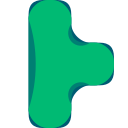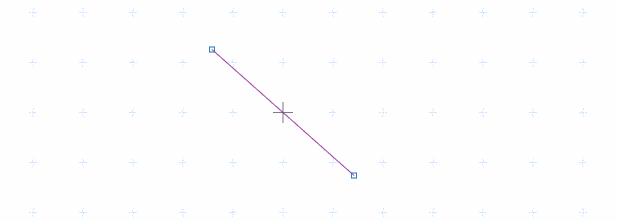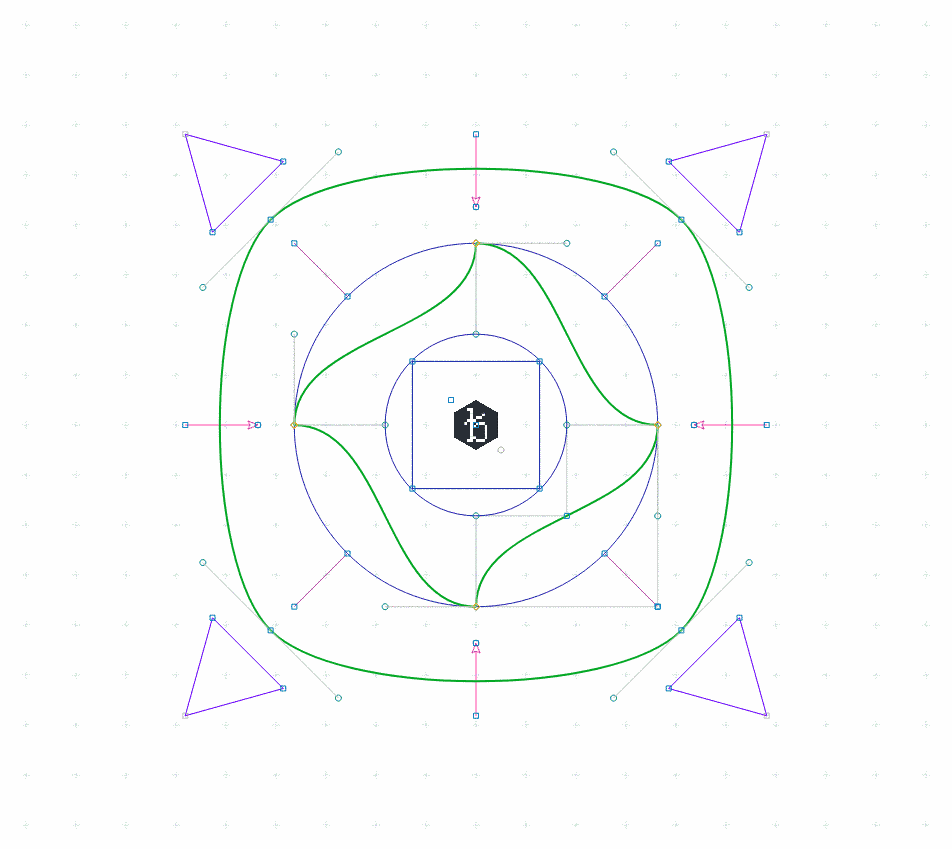Package Exports
- plotboilerplate
- plotboilerplate/src/cjs/index.js
- plotboilerplate/src/esm/index.js
This package does not declare an exports field, so the exports above have been automatically detected and optimized by JSPM instead. If any package subpath is missing, it is recommended to post an issue to the original package (plotboilerplate) to support the "exports" field. If that is not possible, create a JSPM override to customize the exports field for this package.
Readme
An interactive Javascript Plotting Boilerplate
For plotting visual 2D data with Javascript on HTML canvas (in 2d-context) or SVG nodes.

This is a simple collection of useful functions, methods, classes, algorithms and concepts which I often use for the visualization of 2D geometries. Basic features are
- adding elements like
- configuration of the canvas behavior (fullsize, interaction, raster)
- mouse interaction (zoom, pan, drag elements)
- keyboard interaction
- touch interaction for dragging vertices (mobile devices: zoom, pan, drag elements)
The compressed library has 128kb.
Install the package via npm
# Installs the package
$ npm i plotboilerplateThe HTML file
For a full example see main-dist.html :
<canvas id="my-canvas"> Your browser does not support the canvas tag. </canvas>The element canvas will be used to draw on.
The javascript
var pb = new PlotBoilerplate({
canvas: document.getElementById("my-canvas"),
fullSize: true
});Alternative with SVG elements
Use SVG elements instead of canvas:
<svg id="my-svg"></svg>And pass the SVG element:
var pb = new PlotBoilerplate({
canvas: document.getElementById("my-svg"),
fullSize: true
});Add elements to your canvas
// Create two points:
// The origin is at the visual center by default.
var pointA = new Vertex(-100, -100);
var pointB = new Vertex(100, 100);
pb.add(new Line(pointA, pointB));
// When point A is moved by the user
// then move point B in the opposite direction
pointA.listeners.addDragListener(function (e) {
pointB.sub(e.params.dragAmount);
pb.redraw();
});
// and when point B is moved
// then move point A
pointB.listeners.addDragListener(function (e) {
pointA.sub(e.params.dragAmount);
pb.redraw();
});Typescript
// Usage with Typescript could look like this
import { PlotBoilerplate, Vertex, Line } from "plotboilerplate";
globalThis.addEventListener("load", () => {
const pointA: Vertex = new Vertex(100, -100);
const pointB: Vertex = new Vertex(-100, 100);
console.log(pointA, pointB);
const line: Line = new Line(pointA, pointB);
const pb: PlotBoilerplate = new PlotBoilerplate({
canvas: document.getElementById("my-canvas"),
fullSize: true
});
pb.add(line);
});A full working demo repository about the Usage with Typescript is here.
Screenshot

API
See API Documentation for details.
Screenshot

Examples and Demos
Initialization parameters
| Name | Type | Default | Description |
|---|---|---|---|
canvas |
HTMLCanvasElement | SVGElement | string | null |
The canvas or its query selector string (required). |
fullsize |
boolean | true |
If true, then the canvas will always claim tha max available screen size. |
fitToParent |
boolean | true |
If true, then the canvas will alway claim the max available parent container size. |
scaleX |
number | 1.0 |
The initial horizontal zoom. Default is 1.0. |
scaleY |
number | 1.0 |
The initial vertical zoom. Default is 1.0. |
offsetX |
number | 0.0 |
The initial offset. Default is 0.0. Note that autoAdjustOffset=true overrides these values. |
offsetY |
number | 0.0 |
The initial offset. Default is 0.0. Note that autoAdjustOffset=true overrides these values. |
drawGrid |
boolean | true |
Specifies if the raster should be drawn. |
rasterScaleX |
number | 1.0 |
Define the default horizontal raster scale. |
rasterScaleY |
number | 1.0 |
Define the default vertical raster scale. |
rasterGrid |
boolean | true |
If set to true the background grid will be drawn rastered. |
rasterAdjustFactor |
number | 2.0 |
The exponential limit for wrapping down the grid. (2.0 means: halve the grid each 2.0*n zoom step). |
drawOrigin |
boolean | false |
Draw a crosshair at (0,0). |
autoAdjustOffset |
boolean | true |
When set to true then the origin of the XY plane will be re-adjusted automatically (see the params offsetAdjust{X,Y}Percent for more). |
offsetAdjustXPercent |
number | 50 |
The x- and y- fallback position for the origin after resizing the canvas. |
offsetAdjustYPercent |
number | 50 |
The x- and y- fallback position for the origin after resizing the canvas. |
defaultCanvasWidth |
number | 1024 |
The canvas size fallback if no automatic resizing is switched on. |
defaultCanvasHeight |
number | 768 |
The canvas size fallback if no automatic resizing is switched on. |
canvasWidthFactor |
number | 1.0 |
Two scaling factors (width and height) upon the canvas size. In combination with cssScale{X,Y} this can be used to obtain sub pixel resolutions for retina displays. |
canvasHeightFactor |
number | 1.0 |
Two scaling factors (width and height) upon the canvas size. In combination with cssScale{X,Y} this can be used to obtain sub pixel resolutions for retina displays. |
cssScaleX |
number | 1.0 |
Visually resize the canvas using CSS transforms (scale x). |
cssScaleY |
number | 1.0 |
Visually resize the canvas using CSS transforms (scale y). |
cssUniformScale |
boolean | 1.0 |
If set to true only cssScaleX applies for both dimensions. |
autoDetectRetina |
boolean | true |
When set to true (default) the canvas will try to use the display's pixel ratio. |
backgroundColor |
string | #ffffff |
A background color (CSS string) for the canvas. |
redrawOnResize |
boolean | true |
Switch auto-redrawing on resize on/off (some applications might want to prevent automatic redrawing to avoid data loss from the drae buffer). |
drawBezierHandleLines |
boolean | true |
Indicates if Bézier curve handle points should be drawn. |
drawBezierHandlePoints |
boolean | true |
Indicates if Bézier curve handle points should be drawn. |
preClear |
function | null |
A callback function that will be triggered just before the draw function clears the canvas (before anything else was drawn). |
preDraw |
function | null |
A callback function that will be triggered just before the draw function starts. |
postDraw |
function | null |
A callback function that will be triggered right after the drawing process finished. |
enableMouse |
boolean | true |
Indicates if the application should handle touch events for you. |
enableTouch |
boolean | true |
Indicates if the application should handle touch events for you. |
enableKeys |
boolean | true |
Indicates if the application should handle key events for you. |
enableMouseWheel |
boolean | true |
Indicates if the application should handle mouse wheelevents for you. |
enableSVGExport |
boolean | true |
Indicates if the SVG export should be enabled (default is true). |
enableGL |
boolean | false |
[Experimental] Indicates if the application should use the experimental WebGL features. |
Example
var pb = new PlotBoilerplate({
// HTMLCanvasElement | SVGElement | string
// Your canvas element in the DOM (required).
canvas: document.getElementById("my-canvas"),
// boolean
// If set to true the canvas will gain full window size.
fullSize: true,
// boolean
// If set to true the canvas will gain the size of its parent
// container.
// @overrides fullSize
fitToParent: true,
// float
// The initial zoom. Default is 1.0.
scaleX: 1.0,
scaleY: 1.0,
// float
// The initial offset. Default is 0.0. Note that autoAdjustOffset=true overrides these values.
offsetX: 0.0,
offsetY: 0.0,
// Specifies if the raster should be drawn.
drawGrid: true,
// If set to true the background grid will be drawn rastered.
rasterGrid: true,
// float
// The exponential limit for wrapping down the grid.
// (2.0 means: halve the grid each 2.0*n zoom step).
rasterAdjustFactor: 2.0,
// Draw a crosshair at (0,0).
drawOrigin: false,
// boolean
// When set to true then the origin of the XY plane will
// be re-adjusted automatically (see the params
// offsetAdjust{X,Y}Percent for more).
autoAdjustOffset: true,
// float
// The x- and y- fallback position for the origin after
// resizing the canvas.
offsetAdjustXPercent: 50,
offsetAdjustYPercent: 50,
// int
// The canvas size fallback if no automatic resizing
// is switched on.
defaultCanvasWidth: 1024,
defaultCanvasHeight: 768,
// float
// Two scaling factors (width and height) upon the canvas size.
// In combination with cssScale{X,Y} this can be used to obtain
// sub pixel resolutions for retina displays.
canvasWidthFactor: 1.0,
canvasHeightFactor: 1.0,
// float
// Visually resize the canvas using CSS transforms (scale).
cssScaleX: 1.0,
cssScaleY: 1.0,
// boolean
// If set to true only cssScaleX applies for both dimensions.
cssUniformScale: true,
// boolean
// When set to true (default) the canvas will try to use the display's pixel ratio.
autoDetectRetina: true,
// string
// A background color (CSS string) for the canvas.
backgroundColor: "#ffffff",
// boolean
// Switch auto-redrawing on resize on/off (some applications
// might want to prevent automatic redrawing to avoid data
// loss from the drae buffer).
redrawOnResize: true,
// boolean
// Indicates if Bézier curve handles should be drawn (used for
// editors, no required in pure visualizations).
drawBezierHandleLines: true,
// boolean
// Indicates if Bézier curve handle points should be drawn.
drawBezierHandlePoints: true,
// function
// A callback function that will be triggered just before the
// draw function clears the canvas (before anything else was drawn).
preClear: function () {
console.log("before clearing the canvas on redraw.");
},
// function
// A callback function that will be triggered just before the
// draw function starts.
preDraw: function (draw, fill) {
console.log("after clearing and before drawing.");
},
// function
// A callback function that will be triggered right after the
// drawing process finished.
postDraw: function (draw, fill) {
console.log("after drawing.");
},
// boolean
// Indicates if the application should handle mouse events for you.
enableMouse: true,
// boolean
// Indicates if the application should handle touch events for you.
enableTouch: true,
// boolean
// Indicates if the application should handle key events for you.
enableKeys: true,
// boolean
// Indicates if the application should handle mouse wheelevents for you.
enableMouseWheel: true,
// Indicates if the SVG export should be enabled (default is true).
enableSVGExport: true,
// boolean
// Indicates if the application should use the experimental WebGL features.
enableGL: false
});Events
The Vertex class has basic drag event support:
var vert = new Vertex(100, 100);
vert.listeners.addDragListener(function (e) {
// e is of type Event.
// You are encouraged to use the values in the object e.params
console.log("vertex was dragged by: ", "x=" + e.params.dragAmount.x, "y=" + e.params.dragAmount.y);
});The e.params object
{
// The canvas that fired the event.
element : [HTMLElement],
// The event name.
// Default: 'drag'
name : string,
// The current drag position.
pos : { x : number, y : number },
// A mouse button indicator (if mouse event).
// 0=left, 1=middle, 2=right
button : number,
// A flag indicating if event comes from left mouse button.
leftButton : boolean,
// A flag indicating if event comes from middle mouse button.
middleButton : boolean,
// A flag indicating if event comes from right mouse button.
rightButton : boolean,
// A mouse-down-position: position where the dragging
// started. This will not change during one drag process.
mouseDownPos : { x : number, y : number },
// The most recent drag position (position before
// current drag step).
draggedFrom : { x : number, y : number },
// True if this is a drag event (nothing else available the moment).
wasDragged : boolean,
// The x-y-amount of the current drag step.
// This is the difference between the recent drag step
// and the actual drag position.
dragAmount : { x : number, y : number }
}| Name | Type | Example value | Description |
|---|---|---|---|
element |
HTMLCanvasElement | [HTMLCanvasElement] |
The canvas that fired the event. |
name |
string | drag |
The event name (default is 'drag'). |
pos |
position | { x : 20, y : 50 } |
The current drag position. |
button |
number | 0 |
A mouse button indicator (if mouse event). 0=left, 1=middle, 2=right |
leftButton |
boolean | true |
A flag indicating if event comes from left mouse button. |
middleButton |
boolean | false |
A flag indicating if event comes from middle mouse button. |
rightButton |
boolean | false |
A flag indicating if event comes from right mouse button. |
mouseDownPos |
position | { x : 0, y : 20 } |
A mouse-down-position: position where the dragging started. This will not change during one drag process. |
draggedFrom |
position | { x : 10, y : -5 } |
The most recent drag position (position before current drag step). |
wasDragged |
boolean | true |
True if this is a drag event (nothing else available at the moment). |
dragAmount |
position | { x : 100, y : 34 } |
The x-y-amount of the current drag step. This is the difference between the recent drag step and the actual drag position. |
Mouse, Keyboard and Touch interaction
- [SHIFT] + [Click] : Select/Deselect vertex
- [Y] + [Click]: Toggle Bézier auto-adjustment for clicked bézier path point
- [ALT or SPACE] + [Mousedown] + [Drag] : Pan the area
- [Mousewheel-up] : Zoom in
- [Mousewheel-down] : Zoom out
- Touch & move (1 finger): Move item
- Touch & move (2 fingers): Pan the area
- Touch & pinch: Zoom in/out
Build the package
Browsers support
IE / Edge |
Firefox |
Chrome |
iOS Safari |
|---|---|---|---|
| IE11 & Edge | latest | latest | latest |
Credits
- dat.gui by dataarts
- Neolitec's Color.js class
- FileSaver.js
- AlloyFinger.js
- Ray Casting Algorithm by Aaron Digulla
- Hobby Curves in Javascript by Prof. Dr. Edmund Weitz
- hobby.pdf
- jsHobby
- Blake Bowen's Catmull-Rom demo
- mbostock for the great convex-polygon-incircle implementation
- and for circle-tangent-to-three-lines
- Circle Intersection in C++ by Robert King
- The 'Circles and spheres' article by Paul Bourke
- shamansir/draw_svg.js for manipulating SVG path data strings
- opsb's stackoverflow proposal for converting ellipses sectors to SVG arcs.
- contrast-color-algorithm by Martin Sojka's
- Peter James Lu and Paul Steinhardt for their work on Girih patterns
- Cronholm144 for the Girih texture
- Mapbox's Earcut polygon algorithm
- Rosetta-Code for the Sutherland-Hodgman convex polygon clipping algorithm
- Jos de Jong for the very useful math.js library
- Jack Franklin for the howto-module-tutorial
- Narasinham for the very useful vertex-on-ellipse equations
- Tim Čas for the wrapMax/wrapMinMax functions
- Luc Maisonobe for the Ellipse to cubic Bézier math
- Dr. Martin von Gagern for the equidistant points on ellipse math
- Torben Jansen for the SVG-Arc to elliptic-sector conversion
- 3daddict for the js-stl-parser inspiration
- jburkardt for the obj test files.
Todos
Known bugs
- SVG resizing does not work in Firefox (aspect ratio is always kept, even if clip box changes). Please use PNGs until this is fixed.
- The BBTree.iterator() fails if the tree is empty! (Demos)
- The minifid BBTree and BBTreeCollection files do not export anything. The un-minified does. Why that?
- Arcs and ellipses break when non-uniform scaling (scalex!=scaley) is applied. Convert them to Bézier curves before drawing.
- Currently no more known. Please report bugs.


